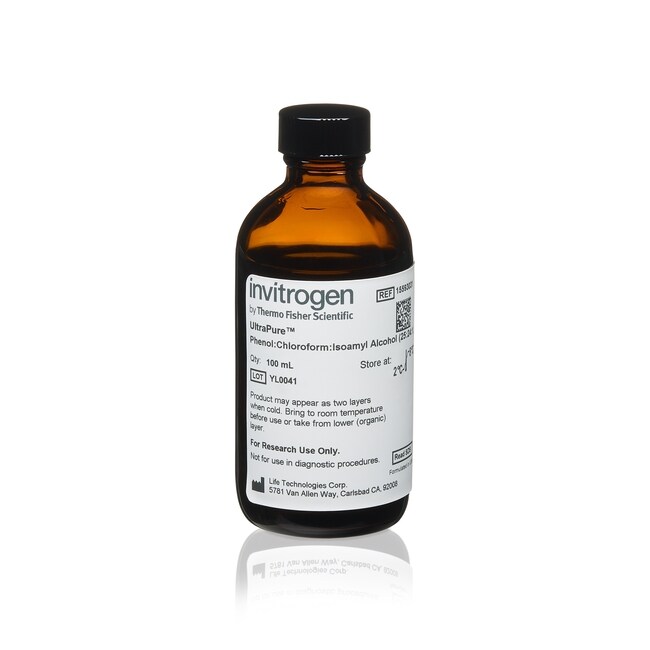Search Thermo Fisher Scientific

Invitrogen™
UltraPure™ Phenol:Chloroform:Isoamylalkohol (25:24:1, v/v)
UltraPure™ Phenol:Chloroform:Isoamylalkohol (25:24:1, v/v) dient zur Aufreinigung von Nukleinsäuren. Dieses Reagenz besteht aus hochreinem Chloroform, Isoamylalkohol und mit Tris-HCl gesättigtemWeitere Informationen
| Katalognummer | Menge |
|---|---|
| 15593031 | 100 ml |
| 15593049 | 400 mL |
Katalognummer 15593031
Preis (EUR)
254,65
Online Exclusive
272,00Ersparnis 17,35 (6%)
Each
Vorrätig
Menge:
100 ml
Preis (EUR)
254,65
Online Exclusive
272,00Ersparnis 17,35 (6%)
Each
UltraPure™ Phenol:Chloroform:Isoamylalkohol (25:24:1, v/v) dient zur Aufreinigung von Nukleinsäuren. Dieses Reagenz besteht aus hochreinem Chloroform, Isoamylalkohol und mit Tris-HCl gesättigtem UltraPure™ Phenol.
Verwendung von Phenol:Chloroform:Isoamylalkohol
Bei der Extraktion von Gemischen mit Phenol:Chloroform:Isoamylalkohol werden Proteine in der organischen Schicht bzw. Grenzschicht denaturiert und gesammelt, während Nukleinsäuren in der wässrigen Schicht verbleiben. UltraPure™ Phenol:Chloroform:lsoamylalkohol enthält keine Konservierungsstoffe. Unter inertem Gas in bruchfesten, kunststoffbeschichteten Braunglasflaschen verpackt.
Wirkungs- und Qualitätskontrolle
Das Aussehen der Lösung ist bei Raumtemperatur zu bewerten. Es wird keine DNase- oder RNase-Aktivität nachgewiesen.
Verwendung von Phenol:Chloroform:Isoamylalkohol
Bei der Extraktion von Gemischen mit Phenol:Chloroform:Isoamylalkohol werden Proteine in der organischen Schicht bzw. Grenzschicht denaturiert und gesammelt, während Nukleinsäuren in der wässrigen Schicht verbleiben. UltraPure™ Phenol:Chloroform:lsoamylalkohol enthält keine Konservierungsstoffe. Unter inertem Gas in bruchfesten, kunststoffbeschichteten Braunglasflaschen verpackt.
Wirkungs- und Qualitätskontrolle
Das Aussehen der Lösung ist bei Raumtemperatur zu bewerten. Es wird keine DNase- oder RNase-Aktivität nachgewiesen.
Nur für Forschungszwecke. Nicht zur Verwendung bei diagnostischen Verfahren.
Specifications
Chemischer Name oder MaterialPhenole
ProduktlinieUltraPure™
ReinheitMolekularbiologische Qualität
Menge100 ml
VersandbedingungRaumtemperatur
FormFlüssig
pHpH 8,05
Unit SizeEach
Inhalt und Lagerung
Bei 2 °C bis 8 °C lagern. Zur Erhöhung der Produktstabilität wird empfohlen, nach jedem Gebrauch das Gasvolumen über der Lösung mit Argon oder Stickstoff zu spülen.